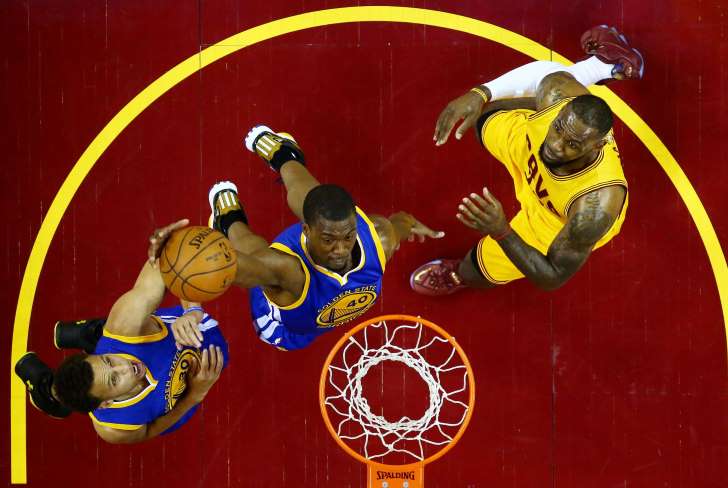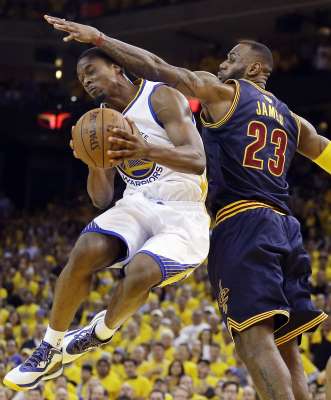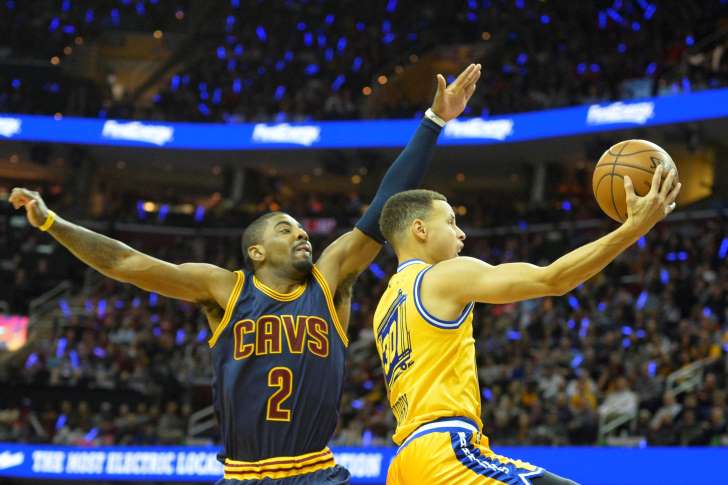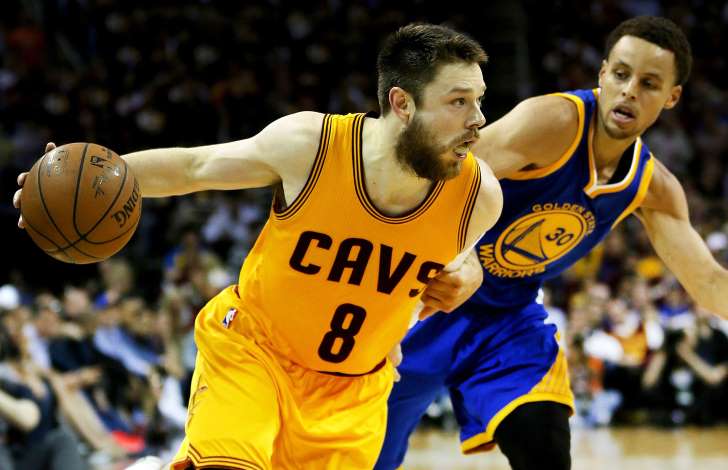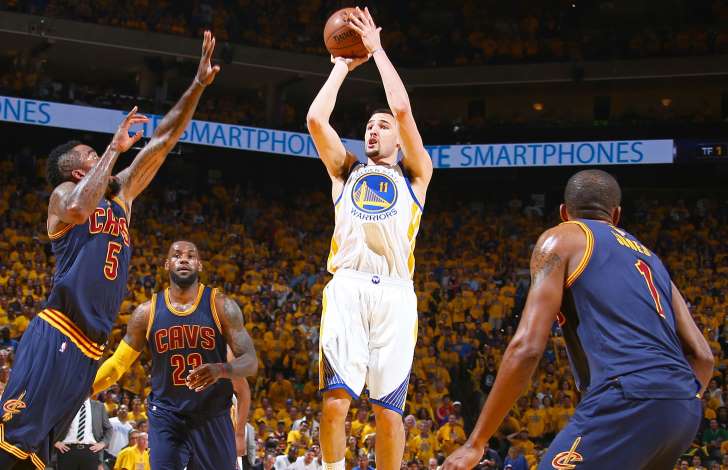Here we are again, just as we all predicted — the Warriors and Cavaliers playing for the NBA title for a second straight year.
It only seems right that we have a proper rematch — last year’s series was compromised by injuries to Cleveland stars Kevin Love and Kyrie Irving. LeBron James did his best and even opened up a 2-1 series lead, but ultimately, the Cavs were overmatched and the Warriors won the series in six games.
This year’s Finals will look drastically different than last year’s. The Cavs are keen to match the Warriors’ up-tempo style and because of that, Cleveland’s personnel is markedly dissimilar to last year’s.
We’ve already been over why the Cavs are at a significant disadvantage should they follow through on their promise to play smallball, but anything can happen when the lights shine brightest — by the end of this series, the gameplan from Game 1 might as well be written in hieroglyphics, it’ll appear so antiquated.
The main storyline of the series is, of course, Stephen Curry vs. LeBron — the victor of that match will likely be taking home the Larry O’Brien Trophy, but there are six other things to keep an eye on as this series unfolds — they might just determine the NBA champions:
Kyrie Irving’s and Kevin Love’s pick-and-roll defense
The Cavaliers’ chances to reach the NBA Finals hinged on the defense of point guard Kyrie Irving, who went from an average defender in the regular season to one of the league’s worst in the playoffs. When Irving is active and engaged on the defensive side — when he gives the Cavs an adequate effort — Cleveland stands a chance, but the track record isn’t great for the offensively brilliant guard, and Stephen Curry is not an easy assignment.
The problems for the Cavs are compounded because Irving isn’t even the worst defender in the Cavs’ starting lineup — not by a long shot. The Cavs’ weakest link in this scenario would be forward Kevin Love.
The Warriors offense doesn’t need any help — it was able to put up points against a Thunder defense that was long, athletic and playing out of its collective mind in the Western Conference Finals — but there’s no way Steve Kerr and his staff aren’t going to expose Love and Irving as often as possible in the NBA Finals.
Teams scored something close to 1.2 points per possession when targeting Love (1 point per possession against when guarding the roll man this season) and Irving (1 point per possession against when guarding the ball handler in the playoffs) in pick-and-roll defense this season, a number so high teams would be foolish not to run the same play, a high 1-4/5 pick-and-roll again and again and again and again. It might seem boring after a while, but winning is never boring.
Factor in that few, if any, duos in the NBA have better offensive chemistry than Curry and Draymond Green, and that the Cavs’ personnel leaves little opportunity to cross-match either susceptible defender out of the fray and the Cavs have a big ol’ issue.
Someone is going to have to clean up the mess. Which brings us to:
LeBron James’ defensive responsibilities
The argument can be made that LeBron is playing with more gravity than ever before in this, his age-31 season. Watching him in the Eastern Conference Finals was to watch a chess grandmaster at work — he knew where every player on the court was at all times, and his effort level on the defensive end put him seemingly in two places at one time. It was a virtuoso performance that was largely unheralded because it wasn’t reflected in the box score.
LeBron will need to take that effort and more or less double it for the NBA Finals.
The Warriors are going to attack Irving and Love — there are no two ways about that — and LeBron, being hands-down the best defender on the court with those two players, is going to have to pick up the slack. In short, LeBron might have to be in three places at one time this series.
Keep an eye on where the Cavs put James on defense early in this series. There’s a paradoxical scenario for the Cavs’ coaching staff: They can put LeBron on Green in pick-and-roll scenarios where he can cover for Irving up high, leaving Love on his own should the ball be passed out of the play, as LeBron cannot provide adequate help-side defense from the wing. Or they can try to keep LeBron as a defensive rover, away from the play, where he can clean up the mess against the driving man of whomever messed up more on the pick-and-roll, but risk allowing Curry to shoot 3-pointers unfettered.
It’s going to take a superhuman effort from James to — in essence — defend three players at one time, especially when those players are this offensively lethal, but seeing how LeBron has played over the past few weeks, it’d be foolhardy to put the responsibility past him.
Draymond Green’s passing ability
Green was taken out of his element in the Western Conference Finals against the Oklahoma City Thunder — a combination of being the center of a scandal and the Thunder’s exquisite defense, which put Green in offensive isolation situations, from which he was rarely able to do much.
But Green won’t have those same problems (well, at least one of them, one would hope) against the Cavs. Remember all the fawning over how valuable Green was to the Warriors when Curry was on the bench with his sprained right MCL? Yeah, we’re probably going to get another cycle of that.
That’s because whatever the Cavs decide to do with LeBron on defense is going to give Green plenty of opportunities to distribute the ball off pick-and-roll.
Should the Cavs try to trap Curry with LeBron, Green will get the ball and essentially have a 4-on-3. (It’s a 4-on-2 if Love is on the court.) And that clear-cut advantage and Green’s preternatural playmaking ability are going to result in serious points for the Warriors, should they recognize the opportunity.
Whatever Harrison Barnes does
Around the Bay Area, the most divisive player on the Warriors isn’t Green, the firebrand, but instead Harrison Barnes, the team’s No. 7 overall pick in the 2012 NBA Draft.
Barnes’ career has been defined by its mercurial nature and the “what if” possibilities that nature invites.
A lot of the scrutiny toward Barnes is fair — he oftentimes lacks offensive aggression, and his help-side defense is hardly LeBron-level — but the UNC product is also deliberately marginalized by the Golden State offensive scheme, and his on-ball defense (82 defensive rating when isolated this season) is particularly underrated.
And given the matchups in this series, Barnes has a chance to make a huge impact.
Barnes’ defensive versatility has been critical for the Warriors ever since the “death” lineup became the team’s go-to unit. Barnes can guard three positions well (2, 3, 4) and is hardly out of his element guarding a back-to-the-basket center or being switched against an elusive point guard. Barnes is the linchpin that makes it all work (not that he’d ever get credit for it).
Considering the Cavs’ stated intent of playing small this series — Tristan Thompson, Channing Frye and Love will be the team’s top-three center choices — Barnes should see significant playing time with the death lineup, which features Green at center, and other iterations of smallball. He might even see time playing the 5.
Furthermore, if Barnes starts the series as the Warriors’ sixth man, it would likely provide him the opportunity to anchor the team’s second unit offensively — something he hasn’t been asked to do in two years playing for Kerr.
Barnes has shown that he can be an excellent offensive player in isolation in games where he was highlighted, not stowed away in the corner as a decoy. Leading the second unit might provide those opportunities he’s lacked, save for one-off games.
Barnes is going to be tasked with guarding LeBron and probably Love and Frye in this series, and we’ve seen him do good jobs on all three players before. He’s steady on the defensive end, and that, along with his versatility, is a huge boon for the Warriors. But if Barnes can develop into a consistent offensive threat in a new role — even if it’s just for three-minute spans every night — it’ll further widen the talent gap between these two teams.
Second-quarter surges
The Warriors, as is common practice for most teams, rest their best player, Stephen Curry, at the beginning of the second quarter, if they can help it.
But don’t expect the Cavs to rest LeBron when Curry is on the bench. (Superhumans don’t need rest …)
Keeping LeBron on the court against second units has created a massive advantage for the Cavs in second quarters, for obvious reasons. But the Cavs are so good in second quarters, it can’t be explained by the mere presence of LeBron. No, not only is he out there — the Cavs put one potent four-man unit around him.
The five-man squad of LeBron, Matthew Dellavedova, Channing Frye, Iman Shumpert and Richard Jefferson has played the most second-quarter minutes of any Cavs unit in these playoffs, and it is decimating the competition. In their roughly four minutes per game, they have a net rating (points per 100 possessions) of 50. It’s simple, too — the Cavs play a five-out offense (five players around the 3-point line) and run a pick-and-roll with LeBron and Dellavedova more or less every time they bring the ball down the court. LeBron sets the pick, both players cut to the hoop and either scores against a second unit that lacks rim protection (as most all do), or they collapse the defense and dish it out to a typically wide-open deadeye shooter beyond the arc.
That unit has an effective field-goal percentage of 73 in these playoffs, which is astounding.
The Warriors’ second unit can’t match up with that five-out set in their current rotations. So for all the problems the Cavs could have defensively with their starters, they could get those points back at the start of the second quarter should the Warriors not rethink player deployment.
Three-point variance
The Cavaliers figured out that they were going to have to shoot a lot of 3-pointers to be successful in the playoffs, and boy did they take that lesson to heart. The Cavs made 134 3s in the first two rounds of the playoffs, setting an NBA record.
The Warriors have, for the last three years, exploited the basic principle that 3>2, and given their prolific shooting talents, it’s worked out tremendously. The Warriors attempted 31 3-pointers per game in the regular season, but the Cavs did them two better in the playoffs.
But as the Warriors could tell Cleveland, shooting the 3 is no sure shot. The further you are from the basket, the more pinpoint you must be — you get an extra point for a reason, it’s harder to make them, even when your form and release is perfect.
There’s tremendous variance when it comes to the 3-pointer, and unless you have two of the greatest shooters of all-time at the top of their game, there’s little any team can do to avoid that variation.
In the Cavs’ four-game sweep of the Hawks, they shot 50.7 percent from beyond the arc. Against Toronto, they came back down to earth, shooting 38.9 percent. Was it a defensive thing? Unlikely — the Hawks are a better defensive team than the Raptors. The simple answer: Sometimes the shots don’t fall. Wish there was a better reason than that.
The variance goes game-to-game as well.
Curry and Klay Thompson create the perception of steadiness amid the noise, but their 3-point shooting varies like everyone else’s, only they have a much higher baseline. The Cavs don’t have players like that — frankly, no one does outside the Bay Area — so the ebbs and flows are wider when it comes to the 3.
But the Cavs have pledged allegiance to the 3-pointer, and they’ll have to double-down considering the competition. The means that J.R. Smith could steal the Cavs a game, maybe two, in this series nearly singlehandedly. He could also shoot them right out of it.
It’s a roll of the dice, every night, and it will go a long way to determining the NBA Champion.


